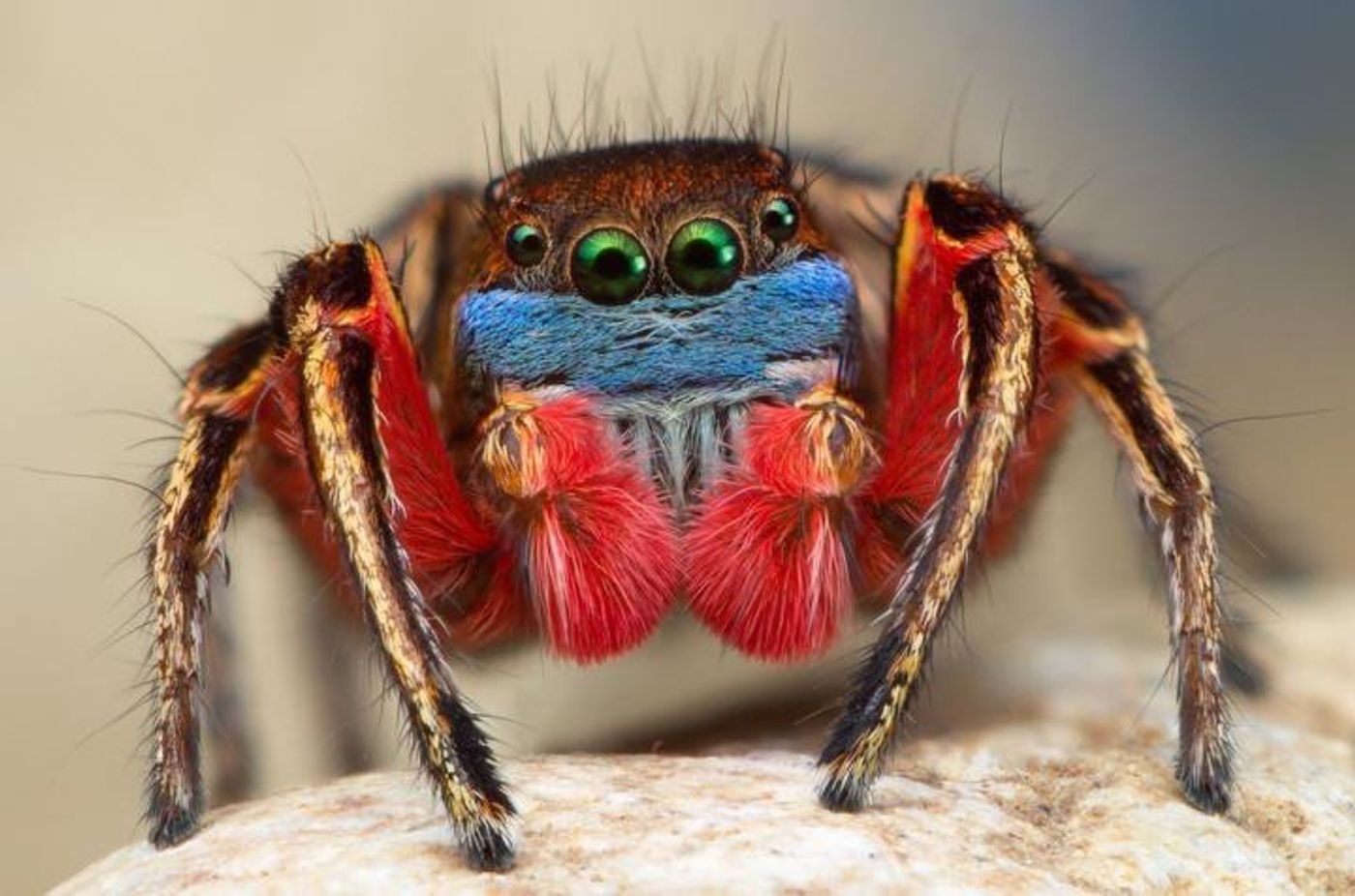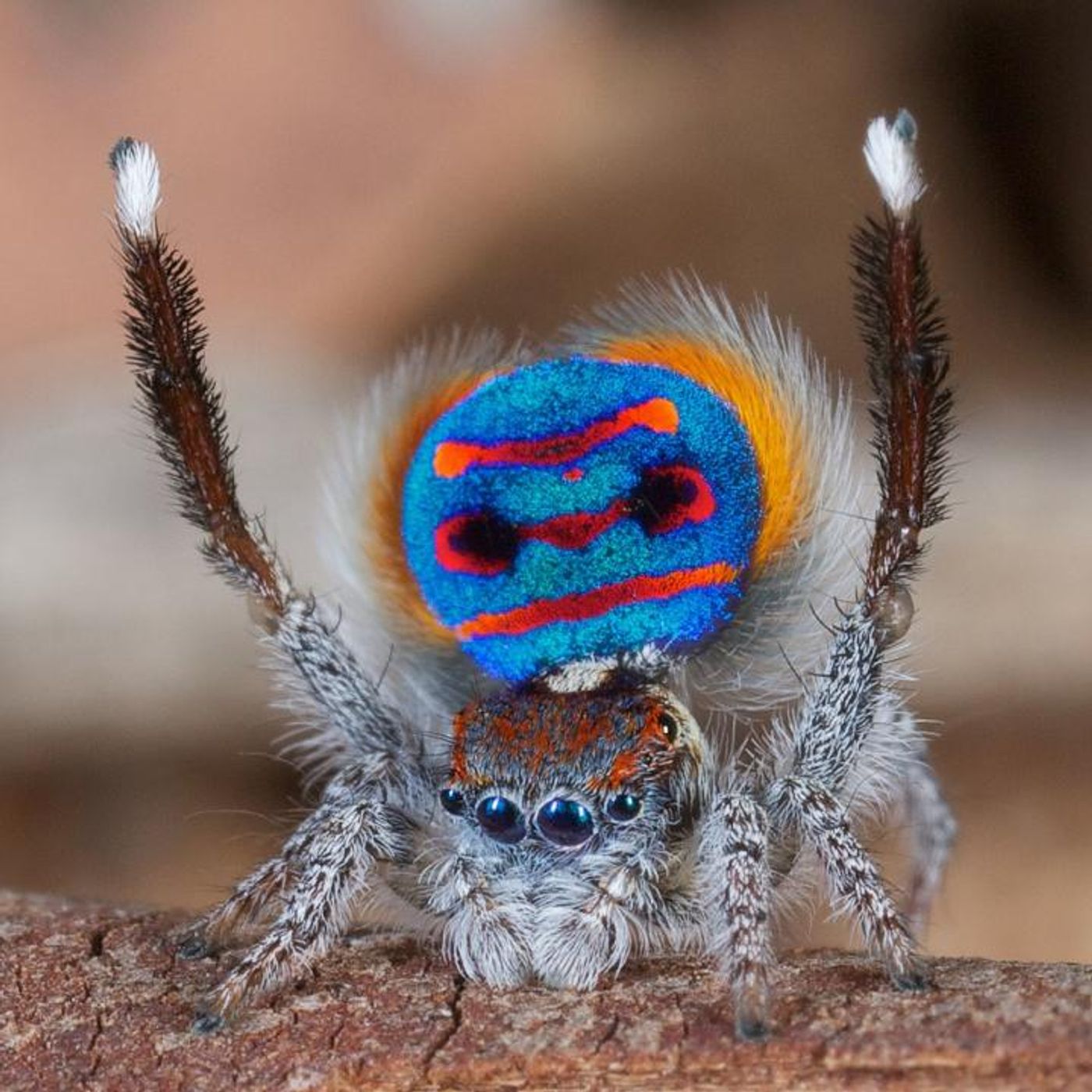Mechanisms of Rare Color Vision in Jumping Spiders
The mating dances of exotic spiders are captivating for sure, but researchers are interested in learning more about how some spiders are able to see in color, an unusual ability in spiders. Nate Morehouse, a biologist at the University of Cincinnati (UC), has been studying these intriguing spiders. He was able to determine that the molecular processes that underlie color vision in two different types of jumping spiders are actually totally distinct processes. The following photo was kindly provided by Thomas Shahan.
"It's rare to see bright colors on most spiders, as they don't usually have the visual sensitivity to perceive color beyond drab blues, greens and browns," explained Morehouse. "But certain groups of jumping spiders deviate from this pattern. They not only possess a unique ability to see reds, yellows and oranges, but the males display those same bright colors on the exterior of their faces and other body parts [that] they use in their elaborate courtship dances."
Smaller than peas, these little arachnids from different continents are the Habronattus jumping spiders of North America and the Maratus "peacock" jumping spiders of Australia. It seems the Habronattus spiders carry a red filter on their retina, and along with retinal cells that are sensitive to green colors, they can thus detect yellows, oranges and reds. Intriguingly, in the Marartus spider color vision system, red colors can be detected but these spiders don’t have any visual filters.
"This is a remarkable discovery, as two different groups of jumping spiders have evolved on opposite ends of the globe. Both have the rare ability to see long wavelength colors like red, orange and yellow," said Morehouse. "But each group has arrived at independent solutions for seeing the color." Morehouse presented his data at the 2017 Annual Society for Integrative and Comparative Biology Conference in New Orleans in January.
Many species of spiders use a mating dance, but most spiders are not able to see in color; the majority can detect colors in the ultraviolet to green spectrum. That visual ability matches the body color of most spiders, as well. There is not much use for color vision if you’re living in a drab world. But both sexes of the vibrantly colored jumping spiders are able to see the vivid pinks, reds and yellows prominently displayed on their bodies.
"Unlike closely related groups of jumping spiders that are drab in appearance, Habronattus spider males have brightly colored faces, legs and knees. And both sexes see these colors thanks to a bright ruby red filter in the middle of their retinas," explained Morehouse. "The Maratus males are also colorful, and they too flash those vibrant body parts to attract their mates, but they don't have the red filter in their retinas like the Habronattus." The following photo was kindly provided by Jurgen Otto.
The Maratus peacock spiders, which are totally unrelated to the Habronattus type of spider, have developed a sense of vision that is not unlike that of many birds. "These Australian peacock spiders have independently arrived at a way of seeing color that is different from the North American spiders," said Morehouse.
Habronattus, which utilizes the filter system for its color sensitivity, does not have as many types of photoreceptor cells that Maratus carries. "These additional photoreceptor cells are likely a product of a gene duplication that has subsequently evolved to be sensitive to a different range of colors, similar to the way humans and other higher primates evolved to see color," explained Morehouse. "Somewhere early in primate evolution the gene responsible for the protein that gives us our green sensitivity got duplicated into two copies. "One of these genes called an opsin gene mutated without affecting the other and those mutations eventually led to one of the copies becoming red sensitive. This may be what happened in the Maratus."
So why do spiders need all this fabulous color? "We think that more effective foraging is the major reason for the evolution of color vision," speculated Morehouse, who is aiming to expand his research to include an unrelated group of spiders in India that are also vibrantly colored. "If we increase our knowledge of additional groups that have transitioned to more sophisticated color vision, we're in an exceptional position to understand why color vision evolves in the first place and what consequences it has for color signaling behavior and the ecology of these species," said Morehouse. "And who knows, perhaps we will find inspirations for novel color sensing technologies."
Check out the video above from Science, featuring the mating rituals of jumping spiders.
Sources: AAAS/Eurekalert! via University of Cincinnati










